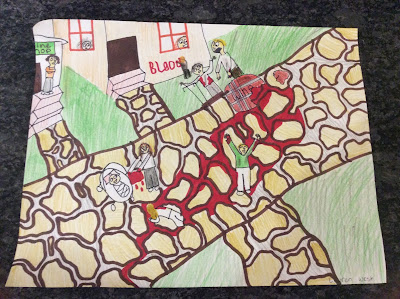Lauren West
Period 4
11/5/15
A Tale of Two cities wine scene illustration
Within the wine spilling scene of the classic story
A Tale of Two Cities, there is an underlying sense of foreshadowing. The seemingly pointless scene, when given more thought, turns out to be a crucial part of the book as it foreshadows events surrounding the French Revolution. The most obvious situation in which this is displayed occurs on page 22 when Dickens writes, "The time was to come, when that wine too would be spilled on the street-stones, and when the stain of it would be red upon many there"(Dickens 22). This quote begins to explain how the red wine spilt upon the streets staining citizens hands symbolizes blood. This scene is in fact not about red wine, but actually the blood that will occur in the future as citizens and peasants are forced to kill for their rights. This idea is also previously mentioned on page 21 when the author writes, "it had stained many hands, too, and many faces, and many naked feet, and many wooden shoes. The hands of the man who sawed the wood, left red marks on the billets; and the forehead of the woman who nursed her baby, was stained with the stain of the old rag she wound about her head again" (Dickens 21). This quote furthers the theory that a battle will occur leaving these innocent people's hands dirty with the blood of their victims. Considering the location and time period the battle may have to do with a riot or fight leading up to the French Revolution. The red wine in this scene by Charles Dickens symbolizes the fighting that peasants of France will later undergo as the French Revolution begins.
In addition, Charles Dickens elaborates on the semblance of hunger throughout the wine scene. The scene in this chapter surrounds peasants and paupers fighting for a drink of wine on the street. Although there is some playfulness to the situation, Charles stresses the dire situation of the peasants as he writes, "Hunger. It was prevalent everywhere. Hunger was pushed out of the tall houses, in wretched clothing that hung upon poles and lines" (Dickens 22). This quote may foreshadow the possibility of how the poor may take part in an uprising due to their hunger for life. During this scene we also see situations of people so desperate for nourishment they are chewing on wine soaked wood and drinking of muddy wine puddles. The scene is disturbing as it shows the extreme situations peasants of France face, and just how desperate they are for reprieve of their poor lives.

No comments:
Post a Comment